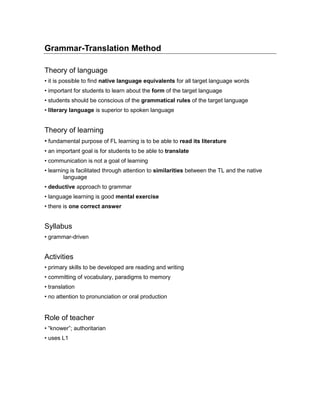
Theory of learning of gtm and audiolingual method
- 1. Grammar-Translation Method Theory of language • it is possible to find native language equivalents for all target language words • important for students to learn about the form of the target language • students should be conscious of the grammatical rules of the target language • literary language is superior to spoken language Theory of learning • fundamental purpose of FL learning is to be able to read its literature • an important goal is for students to be able to translate • communication is not a goal of learning • learning is facilitated through attention to similarities between the TL and the native language • deductive approach to grammar • language learning is good mental exercise • there is one correct answer Syllabus • grammar-driven Activities • primary skills to be developed are reading and writing • committing of vocabulary, paradigms to memory • translation • no attention to pronunciation or oral production Role of teacher • “knower”; authoritarian • uses L1
- 2. Direct Method Theory of language • language is viewed primarily as speech rather than writing • vocabulary is emphasized over grammar; although work on all four skills occurs from the beginning, oral communication is seen as basic; reading and writing exercises are based on what the students practice orally first • native language is not used in the classroom; when teacher introduces a new target language word or phrase, its meaning is demonstrated through the use of realia, pictures, pantomime; • pronunciation receives attention from the beginning Theory of learning • grammar should be taught inductively; avoidance of explicit grammar rules • the purpose of language learning is communication; therefore, a great emphasis is put on questions and answer activities • students learning better through self-correction Syllabus • situational Activities •Q&A • opportunities for “real-life” conversational practice • spoken before written Role of teacher • demonstration rather than translation or explanation
- 3. Audiolingual Method Theory of language • language is composed of structural building blocks (sounds, syllables, morphemes, words, sentences, phrases) • particular parts of speech occupy particular slots in sentences; in order to create new sentences, students learn which part of speech can go into which slot • language forms do not occur by themselves; they occur in context • native language and target language have separate systems; they should be kept apart so that students’ native language interferes as little as possible with target language • speech is more basic than writing • the “natural order” (i.e. the order in which children learn) is listening, speaking, reading, writing • each language has a finite number of patterns; pattern practice helps students to form habits which enable them to use the patterns. • language cannot be separated from culture Theory of learning • language learning is a process of habit formation; the more often an item is repeated, the stronger the habit formation and the greater the learning • it is important to prevent learners from making errors; errors lead to bad habits, and should be immediately corrected by the teacher • positive reinforcement helps the students to develop correct habits • students should “overlearn,” i.e. learn to answer automatically with no analysis • the major objective of language teaching should be the acquisition of structural patterns; students will learn vocabulary afterward. • the learning of a FL should be the same as the acquisition of the native language; we do not need to memorize rules in order to use our native language; the rules necessary for target language use will be figured out or learned through induction • contrastive analysis will reveal those areas where native language habits need to be replaced by target language habits Syllabus • grammar-driven, but structural — not by traditional Latinate categories Activities • memorize dialogs • drills based on dialog (repetition, substitution, transformation) • spoken before written; in sum, learn good habits; emphasis on accuracy (native-like speech) Role of teacher • provides correct model of native language for mimicry • reinforces good habits; punishes bad habits